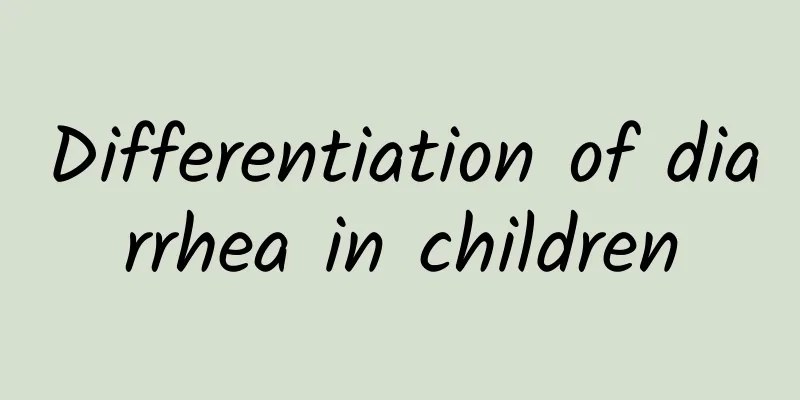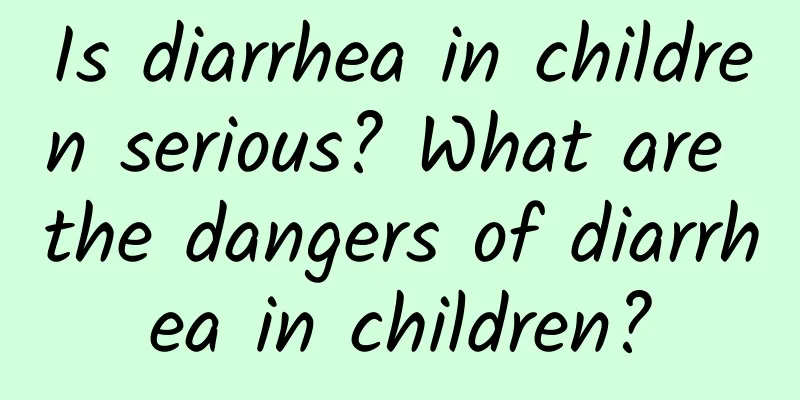Differentiation of diarrhea in children

|
With the arrival of summer, all kinds of cold foods are available. For children, there is one more delicious food. Summer is also a season when bacteria are easy to breed, which can easily cause diarrhea in children. Summer diarrhea in children is determined by the physiological characteristics of children. Children's diarrhea may also be accompanied by symptoms such as vomiting, abdominal distension, and poor spirits. If you find that your baby has diarrhea, early diagnosis and early treatment are recommended. The following is the diagnosis of children's diarrhea: Diagnosis of diarrhea in children The clinical diagnosis is made based on the onset season, medical history (including feeding history and epidemiological data), clinical manifestations and stool characteristics, combined with routine stool examination, bacterial culture, complement fixation test, enzyme-linked immunosorbent assay and electron microscopy. Dehydration, acidosis and electrolyte imbalance must be determined. Clinical diagnosis can be easily made based on medical history, physical examination and stool characteristics. According to the duration of diarrhea and the severity of symptoms, the stage and type of diarrhea can be determined; the presence of dehydration and the degree and nature of dehydration, acidosis and electrolyte imbalance can be determined, and the cause of the disease can be sought, such as improper feeding, internal and external intestinal infection, etc. (I) Diagnostic basis 1. Changes in stool characteristics, such as loose stools, watery stools, mucous stools, or bloody stools. 2. More frequent bowel movements than usual. (II) According to the course of the disease, it is divided into 1. Acute diarrhea - the course of the disease is within 2 weeks. 2. Protracted diarrhea - the course of the disease is between 2 weeks and 2 months. 3. Chronic diarrhea - the course of the disease is more than 2 months. (III) According to the condition, it is divided into 1. Mild, no dehydration, no poisoning symptoms. 2. Medium, mild to moderate dehydration or mild poisoning symptoms. 3. Severe, severe dehydration or obvious poisoning symptoms. (IV) Etiological diagnosis 1. Infectious diarrhea: 1) For acute enteritis, the most likely pathogen can be estimated based on stool characteristics, stool microscopy, epidemic season and age of onset, which can be used as a reference for medication. Watery stools in epidemic diarrhea are mostly caused by rotavirus or toxigenic bacteria, especially in infants under 2 years old. If it occurs in autumn and winter, rotavirus enteritis is more likely; if it occurs in summer, ETEC enteritis is more likely. If the stool is mucus or purulent, invasive bacterial infection should be considered, such as EIEC enteritis, Campylobacter jejuni enteritis or Salmonella enteritis. 2) Units with conditions should conduct etiological examinations such as bacteria, viruses and parasites. Stool bacterial culture can be performed for patients with more white blood cells in stool microscopy; patients suspected of viral enteritis can obtain stool filtrate or centrifugation supernatant in the acute phase (within 3 days of onset) and stain them with electron microscopy or immunoelectron microscopy; immunological methods (such as ELISA, solid phase radioimmunoassay, etc.) can also be used to detect viral antigens in stool and specific antibodies in serum. Viral RNA gel electrophoresis can directly extract RNA from feces, and rotavirus electrophoresis typing can be performed according to the characteristic RNA spectrum, which is divided into long and short types. Although serological examinations of patients with intestinal infections caused by various pathogens are not very helpful in clinical practice, they are quite meaningful for epidemiological surveys and retrospective diagnosis. After the pathogen is identified, it can be diagnosed according to etiology, such as pathogenic Escherichia coli enteritis, Campylobacter jejuni enteritis, rotavirus enteritis, etc. 2. Non-infectious diarrhea: Based on medical history, symptoms and examination analysis, it can be diagnosed as bait diarrhea, symptomatic diarrhea, allergic diarrhea, etc. (V) Assessment of dehydration: The degree and nature of dehydration, electrolyte imbalance and acidosis are determined based on clinical manifestations, blood electrolytes and carbon dioxide binding capacity measurements. The above is about the diagnosis of pediatric diarrhea. Children with severe diarrhea should be sent to the hospital for treatment as soon as possible to prevent the condition from getting worse and threatening your child's health or even life. Because the baby is still young and the gastrointestinal tract is not yet fully developed, parents must feed the baby scientifically and rationally, and give the baby less cold drinks. |
<<: How to diagnose diarrhea in children
>>: Diarrhea examination in children
Recommend
What does low HBA mean?
What does low HBA mean? In simple terms, low HBA ...
What is a pointed chin?
A pointed chin is a facial feature in which the c...
How much does it cost to cure pneumonia in children?
How much does it cost to cure pneumonia in childr...
What are the folk remedies for treating polio?
First, let us take a look at what polio is. This ...
How to check and diagnose nutritional metabolic deficiencies? What are the common detection methods for nutritional metabolic deficiencies?
In a broad sense, nutritional metabolic deficienc...
Are livestock the source of hand, foot and mouth disease?
The main source of infection for hand, foot and m...
What are the folk remedies for treating patent ductus arteriosus?
What are the folk remedies for treating patent du...
What to do if your baby has a cough and fever? How to treat your baby's cough and fever
Children's immunity is not as good as that of...
What is the difference between herpetic pharyngitis and hand, foot and mouth disease in children?
Both herpetic pharyngitis and hand, foot and mout...
How to check for mumps accurately?
Many friends will have symptoms of mumps, which b...
How long does it take to cure pneumonia in children?
If pneumonia is not treated, there will be many s...
Can I pinch the Renzhong point when a child has convulsions?
Pinching the Ren Zhong point during a child's...
What foods are good for children with cough? What should we pay attention to when children have cough?
If a child has a cough, you can choose to eat som...
Are antibiotics effective in treating pneumonia in children? Is it necessary to keep the indoor air fresh for children with pneumonia?
Now that autumn and winter have arrived, children...
What to do if your child has a cough and fever
When a child has a cough and fever, you can reaso...









